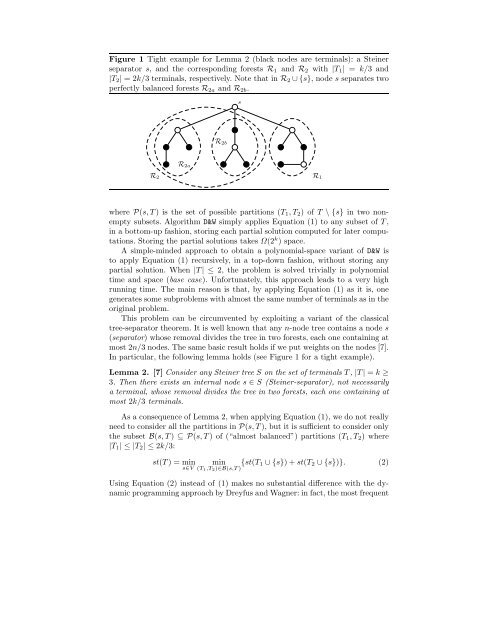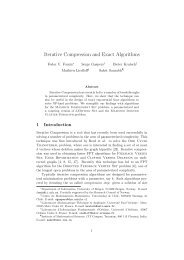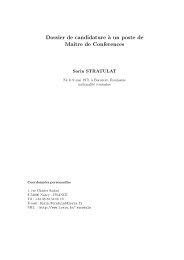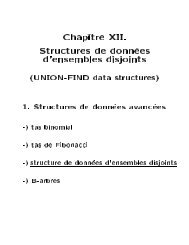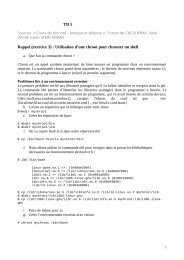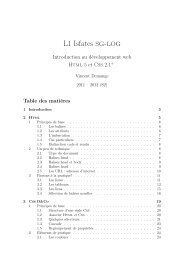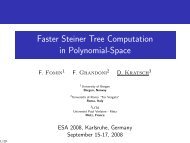Fast Steiner tree computation in polynomial space - Lita
Fast Steiner tree computation in polynomial space - Lita
Fast Steiner tree computation in polynomial space - Lita
You also want an ePaper? Increase the reach of your titles
YUMPU automatically turns print PDFs into web optimized ePapers that Google loves.
Figure 1 Tight example for Lemma 2 (black nodes are term<strong>in</strong>als): a <strong>Ste<strong>in</strong>er</strong><br />
separator s, and the correspond<strong>in</strong>g forests R1 and R2 with |T1| = k/3 and<br />
|T2| =2k/3 term<strong>in</strong>als, respectively. Note that <strong>in</strong> R2 ∪{s}, nodes separates two<br />
perfectly balanced forests R2a and R2b.<br />
R2<br />
R2a<br />
R2b<br />
s<br />
where P(s, T ) is the set of possible partitions (T1,T2) ofT \{s} <strong>in</strong> two nonempty<br />
subsets. Algorithm D&W simply applies Equation (1) to any subset of T ,<br />
<strong>in</strong> a bottom-up fashion, stor<strong>in</strong>g each partial solution computed for later <strong>computation</strong>s.<br />
Stor<strong>in</strong>g the partial solutions takes Ω(2 k ) <strong>space</strong>.<br />
A simple-m<strong>in</strong>ded approach to obta<strong>in</strong> a <strong>polynomial</strong>-<strong>space</strong> variant of D&W is<br />
to apply Equation (1) recursively, <strong>in</strong> a top-down fashion, without stor<strong>in</strong>g any<br />
partial solution. When |T |≤2, the problem is solved trivially <strong>in</strong> <strong>polynomial</strong><br />
time and <strong>space</strong> (base case). Unfortunately, this approach leads to a very high<br />
runn<strong>in</strong>g time. The ma<strong>in</strong> reason is that, by apply<strong>in</strong>g Equation (1) as it is, one<br />
generates some subproblems with almost the same number of term<strong>in</strong>als as <strong>in</strong> the<br />
orig<strong>in</strong>al problem.<br />
This problem can be circumvented by exploit<strong>in</strong>g a variant of the classical<br />
<strong>tree</strong>-separator theorem. It is well known that any n-node<strong>tree</strong>conta<strong>in</strong>sanodes<br />
(separator) whose removal divides the <strong>tree</strong> <strong>in</strong> two forests, each one conta<strong>in</strong><strong>in</strong>g at<br />
most 2n/3 nodes. The same basic result holds if we put weights on the nodes [7].<br />
In particular, the follow<strong>in</strong>g lemma holds (see Figure 1 for a tight example).<br />
Lemma 2. [7] Consider any <strong>Ste<strong>in</strong>er</strong> <strong>tree</strong> S on the set of term<strong>in</strong>als T , |T | = k ≥<br />
3. Then there exists an <strong>in</strong>ternal node s ∈ S (<strong>Ste<strong>in</strong>er</strong>-separator), not necessarily<br />
a term<strong>in</strong>al, whose removal divides the <strong>tree</strong> <strong>in</strong> two forests, each one conta<strong>in</strong><strong>in</strong>g at<br />
most 2k/3 term<strong>in</strong>als.<br />
As a consequence of Lemma 2, when apply<strong>in</strong>g Equation (1), we do not really<br />
need to consider all the partitions <strong>in</strong> P(s, T ), but it is sufficient to consider only<br />
the subset B(s, T ) ⊆P(s, T ) of (“almost balanced”) partitions (T1,T2) where<br />
|T1| ≤|T2| ≤2k/3:<br />
st(T )=m<strong>in</strong><br />
s∈V<br />
m<strong>in</strong><br />
(T1,T2)∈B(s,T ) {st(T1 ∪{s})+st(T2 ∪{s})}. (2)<br />
Us<strong>in</strong>g Equation (2) <strong>in</strong>stead of (1) makes no substantial difference with the dynamic<br />
programm<strong>in</strong>g approach by Dreyfus and Wagner: <strong>in</strong> fact, the most frequent<br />
R1


